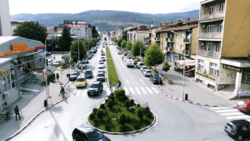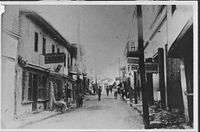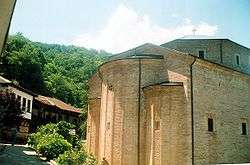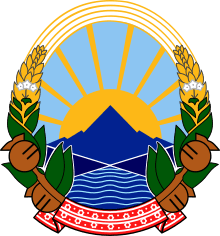Kičevo
Kičevo (Macedonian: Кичево [ˈkitʃɛvɔ] (![]()
Kičevo | |
|---|---|
Town | |
 Kičevo | |
 Kičevo Location within North Macedonia | |
| Coordinates: 41°31′04″N 20°57′56″E | |
| Country | |
| Region | |
| Municipality | |
| Government | |
| • Mayor | Fatmir Dehari (DUI) |
| Area | |
| • Total | 814.3 km2 (314.4 sq mi) |
| Population (2002) | |
| • Total | 27,076 |
| Time zone | UTC+1 (CET) |
| • Summer (DST) | UTC+2 (CEST) |
| Postal code | 6250 |
| Area code(s) | +389 |
| Car plates | KI |
| Climate | Cfb |
Population
The municipality of Kičevo has 56,734 inhabitants, and the city 27,076. The largest ethnic group in the city of Kičevo is the Macedonians who constitute for 15,031 people (55.5%), followed by the Albanians with 7,641 people (28.2%), the Turks with about 2,406 (8.9%) and Roma with 4.9%.[1]
Orthodox Christians made up 15,139 (55.9%) of the city's population according to the 2002 census, while Muslims were the second-largest religious group in the city, numbering 11,759 (43.4%).
The most common native languages are Macedonian (62.5%), Albanian (28.2%), Turkish (8.0%) and Romani 0.4%.
| Ethnic group |
census 1948 | census 1953 | census 1961 | census 1971 | census 1981 | census 1994 | census 2002 | |||||||
|---|---|---|---|---|---|---|---|---|---|---|---|---|---|---|
| Number | % | Number | % | Number | % | Number | % | Number | % | Number | % | Number | % | |
| Macedonians | .. | .. | 3,747 | 39.2 | 6,809 | 66.0 | 9,900 | 64.3 | 13,236 | 58.9 | 15,255 | 60.7 | 15,031 | 55.5 |
| Albanians | .. | .. | 232 | 2.4 | 681 | 6.6 | 2,284 | 14.9 | 4,516 | 20.1 | 5,902 | 23.5 | 7,641 | 28.2 |
| Turks | .. | .. | 4,749 | 49.7 | 2,079 | 20.2 | 2,041 | 13.3 | 2,175 | 9.7 | 2,175 | 8.7 | 2,406 | 8.9 |
| Romani | .. | .. | 54 | 0.6 | 0 | 0.0 | 17 | 0.1 | 304 | 1.3 | 1,235 | 4.9 | 1,329 | 4.9 |
| Serbs | .. | .. | 484 | 5.1 | 394 | 3.8 | 305 | 2.0 | 203 | 0.9 | 96 | 0.4 | 82 | 0.3 |
| Vlachs | .. | .. | 4 | 0.1 | 0 | 0.0 | 0 | 0.0 | 5 | 0.0 | 15 | 0.1 | 75 | 0.3 |
| Bosniaks | .. | .. | 0 | 0.0 | 0 | 0.0 | 0 | 0.0 | 0 | 0.0 | 0 | 0.0 | 7 | 0.0 |
| Others | .. | .. | 297 | 3.1 | 394 | 3.5 | 846 | 5.5 | 2,040 | 9.1 | 451 | 1.8 | 496 | 1.8 |
| Total | 7,280 | 9,567 | 10,324 | 15,393 | 22,479 | 25,129 | 27,076 | |||||||
Name
The name of the city in Macedonian and other South Slavic languages is Kičevo (Кичево). The name of the city in Albanian is Kërçovë. It was originally known as Uskana among its Illyrian inhabitants. The city was later renamed by Slavs who migrated to the region in the 7th century AD. It is presumed that the present name of the town originates from the name of this settlement populated by the Slavic Brsjaci tribe.[3]
Kicevo was first mentioned as Uskana (Ωξάνα in Ancient Greek) in the reign of Perseus, king of Macedon during the Third Macedonian War (171-169 BC).[4] The next written record of the town did not come until 1018, under the name of Kitsabis or Kitsavis (sometimes slavicised as Kicavis), noted in one of the documents of the Byzantine emperor Basil II.[5] Under the rule of Prince Marko it was known as Katin Grad, because Marko's sister was named Katina.
History

Kičevo was noted in one of the documents of the Byzantine emperor Basil II in 1018, and also mentioned by the Ohrid archbishop Theophilact in the 11th century.
.jpg)
When the region was conquered by the Ottoman Empire, Kičevo was turned into the military and administrative center of the region. Notable monument of that period is a clock tower built in the foothills of the nearby hill called Kichevsko Kale.
In the late 19th and early 20th century, Kičevo was part of the Manastir Vilayet of the Ottoman Empire.
The activities of the Internal Macedonian Revolutionary Organization (IMRO) in the region of Kičevo were initiated by the priest Josif from the monastery of Bogorodica Prečista near the city, supported by many teachers from the neighbouring villages. On August 2, 1903, the Christian citizens of Kičevo participated in the Ilinden Uprising, led by Arso Vojvoda and Yordan Piperkata.
In 1913 Kičevo and the whole region were incorporated in the Kingdom of Serbia. The city was occupied by the Kingdom of Bulgaria during the First world war. It became part of the Kingdom of Serbs, Croats and Slovenes in 1918. From 1929 to 1941, Kičevo was part of the Vardar Banovina of the Kingdom of Yugoslavia.
During World War II, Kičevo was occupied by forces from Fascist Italy and ceded to Albania. On September 9, 1943 after the Armistice of Cassibile, Macedonian and Albanian partisan units disarmed the Italian garrison and took temporary control of the city.[6] Thus, Kičevo became the first city seized by the communist Partisans during the World War II in Macedonia. However, soon after the capitulation of Italy, Nazi Germany occupied that area. The Germans put Balli Kombëtar in charge of Albania under German rule. The city was finally seized by the Communists on November 15, 1944 after German retreat.
In 1945 the area was ceded to Communist Yugoslavia. In 1991 the city became part of the newly proclaimed Republic of Macedonia.
Monuments

Monastery of St. Bogorodica Prečista (Monastery of Immaculate Mother of God) is a significant monastery near Kičevo. Dedicated to the Virgin Mary, Mother of God, the feast day of this monastery is "Mala Bogorodica", (Birthday of the Virgin Mary on the 21st of September). The monastery, dedicated to the Annunciation and lodgings for devout female monks, represents a medieval monastery that was known under the name Krninski monastery in the past.
This monastery is actually an important site for the study of common cult of Christians and Muslims because it is visited by believers from both religions. The reason of this common cult is due to the miraculous powers of the water source inside the monastery.[7]
Another important monument is the monastery of St. George located in the vicinity of Kičevo.
There are also many important mosques from the Ottoman Empire's times of rule and from the Islamic population.
Sports
Local football club FK Napredok has spent several seasons in the Macedonian First Football League and KF Vëllazërimi 77 plays in the Macedonian Second League (West Division).
Notable people
- Besart Ibraimi, footballer
- Florian Kadriu, footballer
- Omer Kaleshi, painter
- Yoakim Karchovski, priest
- Vlatko Lozanoski, singer
- Vesna Milošević, former handballer
- Vlado Taneski, journalist and serial killer
- Saint Evnuvios, Paisios and Averikios
References
- Macedonian census, language and religion Archived 2014-03-27 at the Wayback Machine
- Censuses of population 1948 - 2002 Archived 2013-10-14 at the Wayback Machine
- "Ancient Toponymies renamed by Slavs". history-of-macedonia.com. Archived from the original on 8 October 2017. Retrieved 24 April 2018.
- Atanasovski, Goran. "Kicevo - history & culture". travel2macedonia.com.mk. Archived from the original on 16 December 2017. Retrieved 24 April 2018.
- Dalibor Brozović, Hrvatska enciklopedija, 1999, s.v. "Kičevo".
- Pearson, Owen (2006). Albania in Occupation and War: From Fascism to Communism 1940-1945. I.B.Tauris. p. 271. ISBN 1-84511-104-4.
- Dionigi Albera - Maria Couroucli (2013). I luoghi sacri comuni ai monoteismi, tra Cristianesimo, Ebraismo e Islam. Brescia: Morcelliana. pp. 15–34. ISBN 978-88-372-2657-2.

